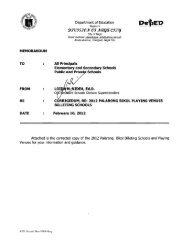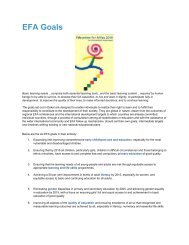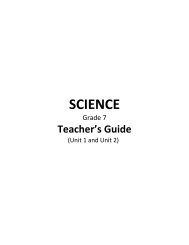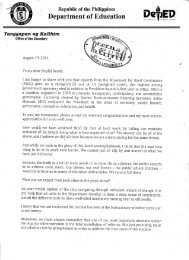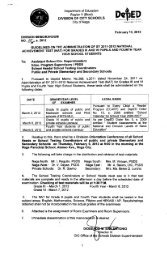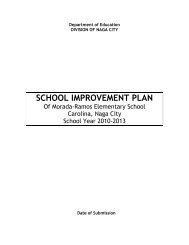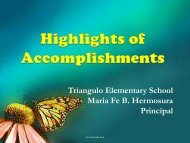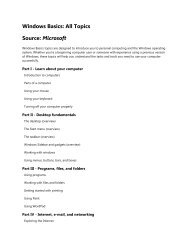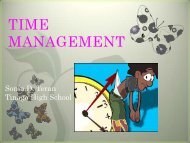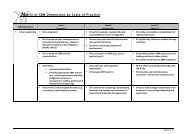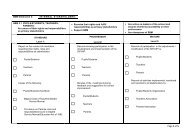K to 12 Curriculum Guide SCIENCE - DepEd Naga City
K to 12 Curriculum Guide SCIENCE - DepEd Naga City
K to 12 Curriculum Guide SCIENCE - DepEd Naga City
You also want an ePaper? Increase the reach of your titles
YUMPU automatically turns print PDFs into web optimized ePapers that Google loves.
K TO <strong>12</strong> <strong>SCIENCE</strong><br />
Grade/Level<br />
K<br />
Grade 1<br />
Grade 2<br />
Grade 3<br />
Grade Level Standards<br />
Concepts and skills in the kindergarten curriculum are taught thematically so that it is difficult <strong>to</strong> identify specific science ideas.<br />
At the end of Grade 1, learners will use their senses <strong>to</strong> locate and describe the parts of their body and tell the shape, color, texture, taste,<br />
and size of things around them. They will differentiate sounds produced by animals, vehicles cars, and musical instruments. They will<br />
illustrate how things move. They will describe similarities and differences, given two things. They will use appropriate terms or vocabulary<br />
<strong>to</strong> describe these features. They will collect, sort, count, draw, take things apart, or make something out of the things. They will practice<br />
health habits (e.g., washing hands properly, choosing nutritious food) and help clean or pack away their <strong>to</strong>ys. They will ask questions.<br />
They will give simple answer/ descriptions <strong>to</strong> probing questions.<br />
At the end of Grade 2, learners will use their senses <strong>to</strong> describe more than two objects and using more than two properties. They can<br />
sort things in different ways and give a reason for doing so. They will describe the kind of weather or certain events in the home or school<br />
and express how these are affecting them. They will tell why some things around them are important. They will decide if what they do is<br />
safe or dangerous. They will give suggestions on how <strong>to</strong> prevent accidents at home (not playing with matches or sharp objects). They will<br />
switch off light when not in use or conserve water when taking a bath or brushing teeth. They will help take care of pets or of plants. They<br />
will tell short s<strong>to</strong>ries about what they do, what they have seen, or what they feel.<br />
At the end of Grade 3, learners will describe the functions of the different parts of the body and things that make up their surroundings ---<br />
rocks and soil, plants and animals, the Sun, Moon and stars. They will also learn that things may be solid, liquid or gas while others may<br />
give off light, heat and sound. They will also observe changes in the conditions of their surroundings. These will lead learners <strong>to</strong> become<br />
more curious about their surroundings, appreciate nature, and practice health and safety measures.<br />
After investigating, learners will identify materials that do not decay and use this knowledge <strong>to</strong> help minimize waste at home, school, and<br />
in the community. They will also investigate changes in the properties of materials when these are subjected <strong>to</strong> different conditions.<br />
Grade 4<br />
The learners will describe the internal parts of the body and their functions in order <strong>to</strong> practice ways <strong>to</strong> maintain good health. They will<br />
classify plants and animals according <strong>to</strong> where they live and observe interactions among living things and their environment. They will infer<br />
that plants and animals have traits that help them survive in their environment.<br />
Learners will investigate which type of soil is best for certain plants and infer the importance of water in daily activities. They will learn<br />
about what makes up weather and apply their knowledge of weather conditions in making decisions for the day. Learners will also infer the<br />
importance of the Sun <strong>to</strong> life on Earth.<br />
Learners will investigate the effects of push or pull on the size, shape, and movement of an object<br />
K <strong>to</strong> <strong>12</strong> <strong>Curriculum</strong> <strong>Guide</strong> Science – version as of January 31, 20<strong>12</strong> 5




